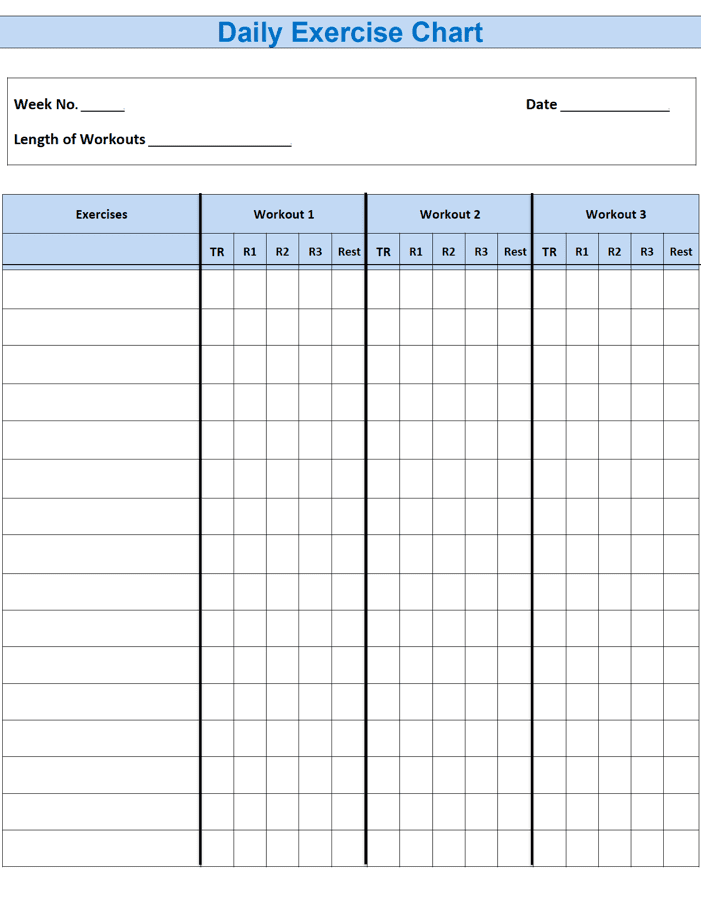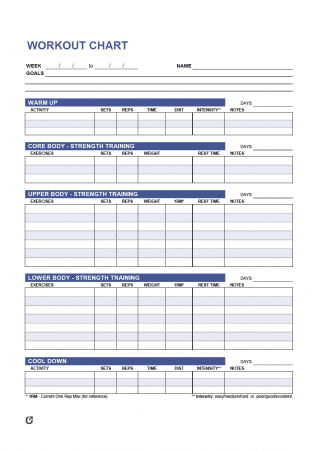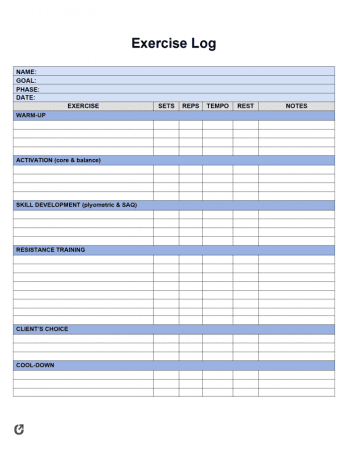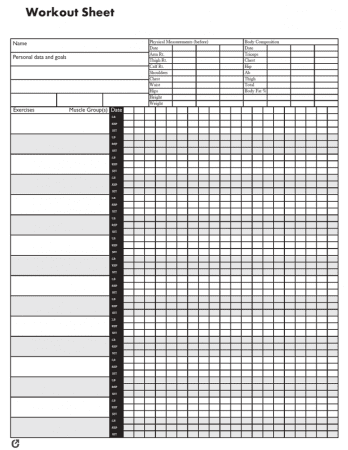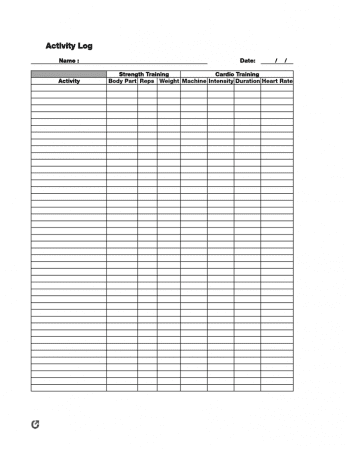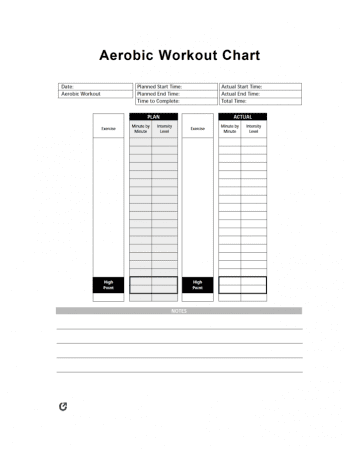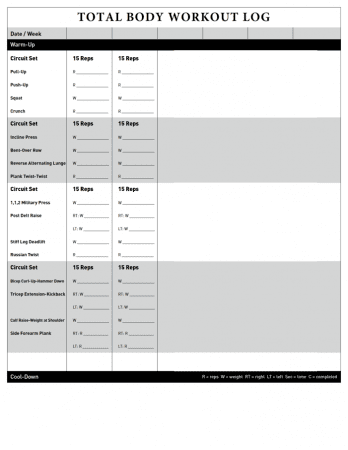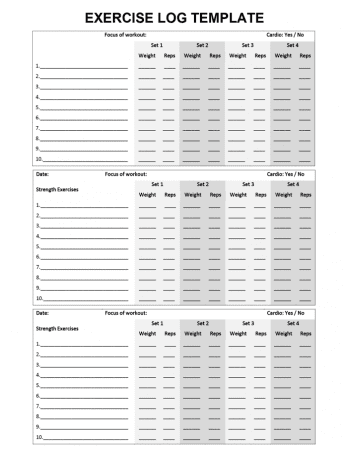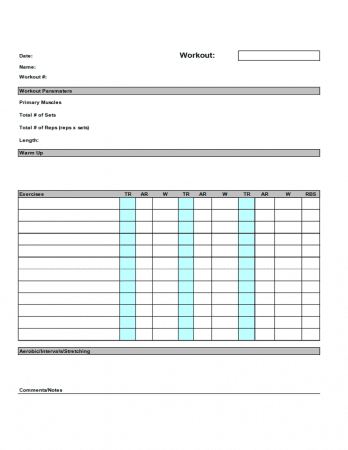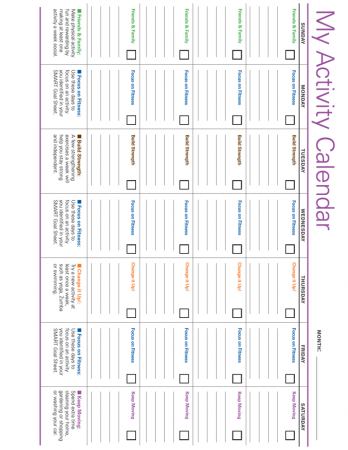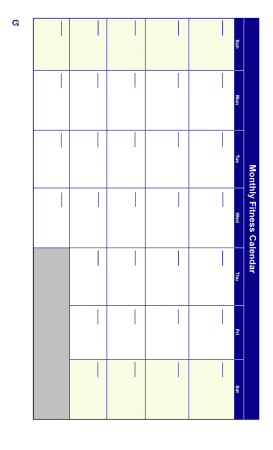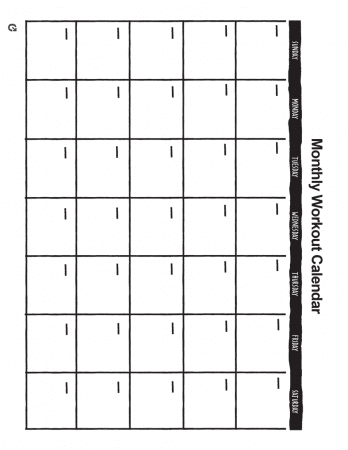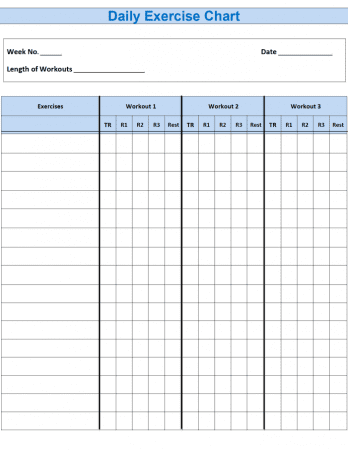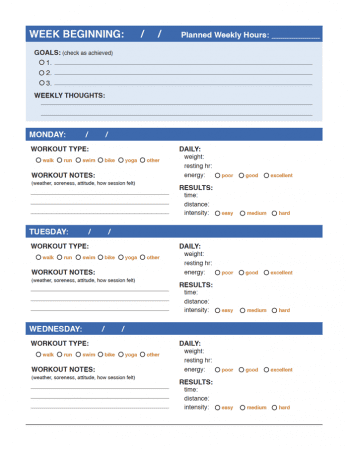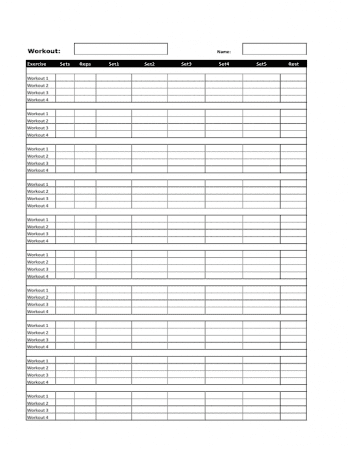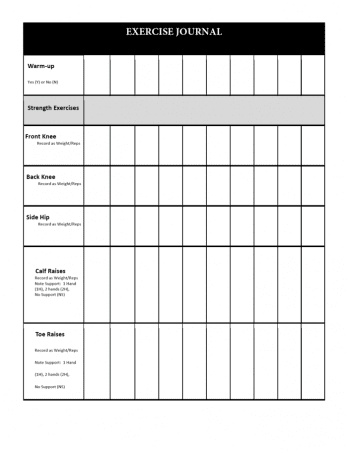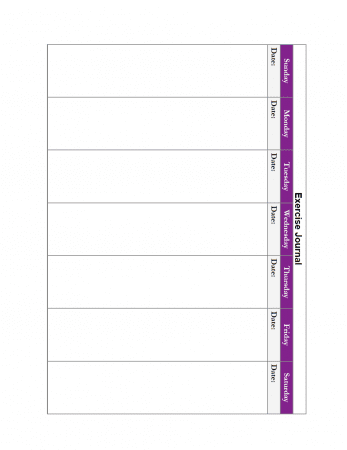Exercise Chart Templates
An exercise chart is a document that allows individuals to organize and track their exercise routines. While exercise charts follow a similar format, each form contains unique fields to accommodate the needs of people using them.
An exercise organizer can help people monitor their daily, weekly, or monthly routines. It can also allow them to sort their workouts by activity type. For example, they might use a chart to record warm-up and cool-down exercises. On the other hand, they may opt for a template that focuses on reps and sets for core, upper body, and lower body strengthening workouts.
Exercise charts can also help a person to monitor their weight regularly. They can include daily or weekly weigh-ins, physical measurements, and body composition percentages.
Charts for exercising assist people with starting a new fitness regimen, arranging a regular workout routine, and setting incremental goals. These templates are beneficial for people who have little to no experience exercising; however, individuals of any expertise can use them.
Exercise Chart Templates
How to Make an Exercise Chart
Follow the steps below to create a chart for setting and monitoring your exercise goals.
- Step One – Choose a Chart
- Step Two – Enter Workout Routine
- Step Three – Include Rest Days
- Step Four – Download or Print Chart
Step One – Choose a Chart
There are many templates to choose from when following a workout routine. Therefore, it is crucial to select the best fit for your individual needs.
Consider how often you want to track your workouts and the information you want to monitor. For example, you might choose a template that allows you to plan for daily, weekly, or monthly activities.
However, you might find it more helpful to use a template that sorts workouts by their types, such as cardio or strength training. Furthermore, individuals setting incremental goals, such as training for a 5k race, may find a worksheet with objectives or targets most beneficial.
Step Two – Enter Workout Routine
After selecting a chart, determine your goals for your workouts and monitoring. If you want to lose weight, set a specific amount you would like to lose and your plan for reaching the target number of pounds. However, if you’re going to focus more on strength or physical improvements, write down your strategy for achieving that amount and the method of measuring. Once you have concreted your goals, enter your exercise chart’s goals, schedules, or additional information.
Example 1: Cindy wants to lose 15 pounds in 3 months. She plans to use a chart to track her weight and exercise schedule to reach her goal. After calculating her weight, Cindy sets a goal to lose about one and one-quarter pounds each week. She completes an exercise chart that includes the workouts she needs to do each week and a daily weigh-ins section to reach her target weight.
Example 2: Jim has signed up for a 10k race and has two months to decrease his run time. He downloads and prints an exercise chart to establish a running routine that will increase his speed. Each day, Jim reviews the chart to see his workout schedule. After every exercise, he writes down the time that it took him to run to see his speed increase over time.
Setting realistic goals is essential for any workout routine to keep it a regular habit. Exercise charts assist individuals in accomplishing these goals while tracking their health. Along with goal setting, exercise organizers also help people notice improvements over time. As a result, they often feel more motivated and satisfied in their workout routine.
Step Three – Include Rest Days
Many people think taking time to rest goes against their commitment to exercise. However, taking a day or two for relaxation can benefit a fitness routine. Individuals are more likely to stick to a schedule with built-in breaks. Rest days also allow muscles to recover, which can aid in achieving more fitness gains down the line.
Example 3: George goes to the doctor and finds out that he has high blood pressure. His doctor recommends using an exercise chart to start a workout routine to lower his risk of heart disease, stroke, and other cardiovascular diseases. George downloads an exercise chart calendar, which allows him to enter his workouts during the month, along with his rest days. By reading the chart daily, he knows which movements or activities he needs to do to achieve his goal. George feels satisfaction in knowing that he can lower his blood pressure by following the monthly routine he has created for himself.
Step Four – Download or Print Chart
Once the chart is complete, download and save it to a folder. Doing so allows for editing or updating the chart as needs or goals evolve. Print the chart and put it in a visible place, such as a refrigerator or bathroom mirror. Seeing it frequently will serve as a good reminder, which helps maintain the routine.
Printable Exercise Charts
Exercise Categories
A good workout regimen has variety and provides a total-body workout, thus improving overall results. Here are examples of categories to include in an exercise chart.
Endurance
This type of workout aims to increase heart rate, breathing, and overall endurance. Exercises for this category include jogging, swimming, cycling, stair climbing, or dancing.
Strengthening
Strength-training exercises aim to increase muscle mass and decrease fat mass. Routines that focus on weightlifting or resistance help achieve these goals. Examples include bodyweight exercises (i.e., sit-ups or squats), resistance machines, or free weights. Individuals who engage in challenging yard work can also log it as a workout.
Balance
Exercises in this category improve balance and reduce the risk of falls and injuries. They also help strengthen muscles and increase speed. Balance exercises are especially important for older adults or individuals recovering from an injury. Low-impact and easily adaptable activities include certain yoga poses, pilates, or utilizing balance equipment.
Flexibility
Exercises for flexibility strengthen muscles and improve range of motion, posture, and blood circulation. They also ease muscle tension and help induce relaxation. These stretches can be static (held in position) or dynamic (utilizing movement) and focus on specific muscle areas. Using equipment, such as straps or blocks, helps with varying degrees of flexibility.
Which Stretching Exercise is Usually Not Recommended?According to the International Journal of Sports Physical Therapy (IJSPT), experts no longer recommend ballistic stretching. This exercise consists of quick, bouncing movements at the end range of motion when stretching. Due to reported injuries and increased risk of muscle damage, experts have taken it off of the list of suggested stretching exercises. |
Exercise Log Templates
How to Maintain an Exercise Routine
Keep the chart in a visible place. It will serve as a concrete reminder of the exercise schedule and goals if it is easily noticeable. In addition, set a reminder on a mobile device or app. That way, even throughout a busy week, the exercise routine remains a priority.
It also helps to discuss workout goals with family members, friends, and co-workers. By doing so, they can provide support and accountability for sticking with the routine.
People are more likely to follow through on their fitness commitment if their goals are specific. Non-specific goals, such as “get healthy,” “improve fitness,” or “be more active,” are vague – despite their good intentions. Instead, well-defined goals are easier to follow. Specific goals, like “lose 30 pounds by August 1st” or “hike 50 miles in 100 days,” quantify the outcome and indicate a timeframe for doing so.
Another way to maintain an exercise routine is to note progress toward goals. Keeping a journal, photolog, or another method for tracking progress provides feedback that all the hard work is paying off. It’s also important to reward yourself for making progress. A small reward can go a long way, especially if it means continuing with the exercise regimen.
Exercise Calendar Templates
How Many Calories Does Exercise Burn?
Exercise burns calories, but how many depends on several factors. The following list includes various elements that impact the number of calories a person burns during a workout.
- Type of exercise: There are light, moderate, and strenuous categories of exercises. All are valid and can be a part of an individual’s exercise chart. A light activity, such as cleaning the house, may not burn as many calories as cardio kickboxing, but it can be a good complement.
- Intensity: High-intensity activity burns more calories than one with low intensity. An exercise will burn more calories if a person sweats, has difficulty talking, and has a fast heart rate.
- Time Spent Exercising: A 60-minute ride on the stationary bike will burn more calories than a 20-minute ride, especially if the 60-minute ride is more intense than the 20-minute one. It’s also better to exercise more frequently in a week.
- Metabolism: An individual’s age, weight, genetics, food intake, and medical condition(s) can impact metabolism and ultimately how exercise burns calories. Speak with a dietician or healthcare provider to learn more about individual metabolic and caloric needs.
Daily Exercise Chart Templates
How Much Exercise Do Experts Recommend?The Centers for Disease Control and Prevention (CDC) recommends that the average adult engages in 150 minutes of moderate-intensity aerobic exercise per week. In addition, they must do muscle-strengthening activities on two or more days of the week. Moderate-intensity exercise includes brisk walking, water aerobics, riding a bike on an incline, or pushing a lawnmower. Individuals can also achieve CDC-recommended weekly exercise by doing vigorous-intensity aerobic activities, such as jogging or running, for 75 minutes each week, as well as two days of muscle-strengthening activities. Similarly, they can do both moderate- and vigorous-intensity and strength-training exercises to accomplish the weekly exercise goal. |
Benefits of Exercise
Regular exercise brings a host of mental, physical, and social benefits. It reduces anxiety, depression, ADHD, and OCD symptoms and enables healthy tension release and relaxation.
Exercising also decreases the risk of cancer, high blood pressure, diabetes, arthritis, and other illnesses. In addition, those who exercise regularly are at a lower risk of developing obesity.
People have benefited from improved moods, sleep, self-esteem, and energy levels through regular exercise. It also strengthens cognitive abilities and memory.
Many individuals find social benefits to exercise. By joining gyms, fitness classes, outdoor recreation activities, or intramural sports teams, people make friends and belong to a supportive organization. In turn, this makes exercise appealing.
Exercise Journal Templates
Key Takeaways
Exercise is one of the ways people improve their lives, relationships, and bodies. It helps with weight maintenance, heart health, lung capacity, muscle strength, and mood. Creating a detailed and specific exercise chart is a surefire way to establish goals and stay on track.
